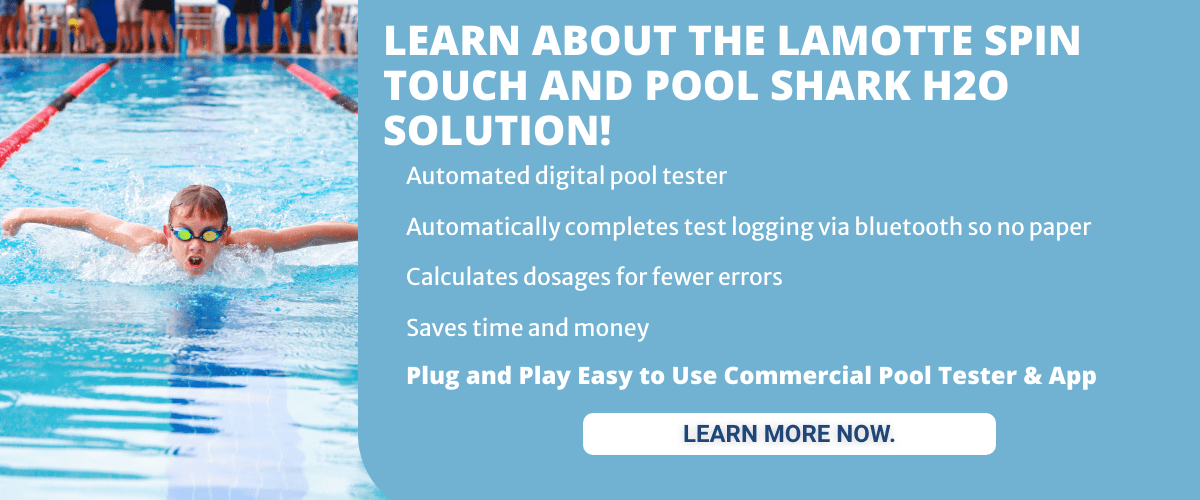Maintaining crystal-clear, healthy pool water is all about balance. Most of the time, routine chemical adjustments keep your pool within state codes and industry standards. But sometimes, the chemical balance drifts too far, and the only real fix is draining and refilling.

So how do you know when to treat with chemicals and when it’s time to start fresh? And what’s the real cost of draining a commercial pool compared to balancing chemically? Let’s break it down.
Why Commercial Pools Sometimes Require a Drain
A drain and refill is not part of everyday maintenance, but for high-use pools, buildup happens faster than in residential environments. With thousands of gallons circulating daily and heavy swimmer load, certain elements accumulate to levels chemicals can’t correct.
- Cyanuric Acid (CYA): CYA, also known as pool stabilizer, protects chlorine from sun-caused degredation. However, it doesn’t degrade like chlorine does and if your pool is using “stabilized chlorine,” you may be continuously adding far more stabilizer than you need. Once levels climb too high, chlorine loses effectiveness, leaving operators vulnerable to code violations and unsafe water. Dilution is the only option.
- Calcium Hardness: Commercial pools with hard fill water see scaling, cloudy water, and damage to tile, heaters, and filtration systems. But water evaporation, for example in hot climates or in pools with high bather loads, regular use of Cal-Hypo, high-aeration features like fountains and splash pads, and pH and alkalinity imbalances can also cause excess calcium.There are a few methods you can try here:
- Add a flocculant: Flocculants bind to calcium particles then settle them to the floor where you can vacuum them. However, this method is only effective for mild cases.
- Set up a Reverse Osmosis system to soften water: this method is effective, but expensive, so is best used when you have really elevated calcium levels and/or calcium hardness is an ongoing issue.
- Drain and refill: While there is also a cost to drain the pool, it may make the most sense to start fresh. If your calcium levels are mild to moderately high, you can also try a partial drain to both reduce costs and downtime. It’s best to refill water with soft water if possible.
- Total Dissolved Solids (TDS): Every chemical and swimmer byproduct adds to TDS. Once the threshold is exceeded, disinfectants underperform, and water clarity suffers. At this point, continuing to dump chemicals in the pool won’t solve the problem.
When Chemicals Are the Right Fix
Not every issue calls for a drain. pH, alkalinity, chlorine residual, phosphates, and even mild algae events can be corrected with targeted chemicals. With the right testing and dosing, you can usually restore water without downtime.
The challenge for pool operators is determining whether chemicals will get you back into compliance or if you’re at risk of burning through budget and labor hours chasing numbers that won’t stabilize. Tools like Pool Shark H2O provide clear and accurate guidance so you can make that decision with confidence. If our app recommends multiple large adjustments or replacing most of your water through dilution, it may be cheaper and faster to reset with a drain.
What’s the Cost to Drain a Commercial Pool?
Costs scale with the size of the facility, local water pricing, and whether in-house staff or outside vendors handle the process.
- Water Replacement: Refilling a 100,000-gallon pool can range from $300 to $1,500 in water alone, depending on municipal rates.
- Labor & Service Fees: Hiring a pool company may add $500–$1,500 for draining, monitoring, and startup balancing. Even if handled internally, expect added labor hours.
- Startup Chemicals: Fresh water still requires balancing, which means you’ll need to account for the costs to fill and balance your water with fresh chemicals.
- Downtime: A drain-and-refill can close your pool for 1–3 days—an often overlooked but significant cost no matter what kind of facility you’re running.
Altogether, a full drain and refill can run $1,000 to $3,500+ depending on pool size and region.
Safety Considerations for Draining Commercial Pools
Draining a pool, especially a large one, requires caution:
- Never fully drain without checking conditions. Commercial shells can “float” or pop if groundwater pressure is high. Many facilities only do partial drains unless the structure and conditions are verified safe.
- Shut off circulation pumps. Prevent pumps from sucking air and burning out during draining.
- Schedule strategically. Draining in peak season may not be feasible. Many operators plan partial or full drains during off-peak months or shutdowns.
- Follow local codes. Some municipalities regulate where and how pool water can be discharged.
For large public pools, it’s often best to involve a licensed contractor to manage risks. Any contractor you hire should do pre-drain inspections, including drain checks, prior to starting.
The Bottom Line for Commercial Operators
For commercial and public pools, draining isn’t (and shouldn’t be) routine, but sometimes it’s the only path back to safe, compliant water. High CYA, calcium hardness, and TDS levels simply can’t be corrected with chemicals alone.
The real cost to drain a pool isn’t just water: it’s labor, downtime, and chemicals to restart. That’s why tools like Pool Shark H2O are invaluable. We help operators accurately balance pool water chemistry, preventing unnecessary drains. And when you do have an issue, our user-friendly app makes chemical adjustments clear, so you know when and if a drain is the smarter investment.
Pool Shark H2O provides:
- Precise water analysis so you know when chemical adjustments are sufficient.
- Alerts when CYA, calcium hardness, or TDS levels exceed treatable limits, as well as other times when pool water needs attention or when tests have been missed.
- Cost savings by preventing wasted chemical spend and minimizing downtime.
- Operational efficiency so your staff isn’t spending hours chasing unstable chemistry.
Over time, operators can save thousands annually while maintaining water that’s safe, compliant, and guest-ready.
In the end, that means safer water, lower costs, and fewer surprises: exactly what pool owners, managers, and operators need to run efficient, compliant facilities.



